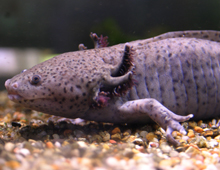Description: Axolotls are also known as Mexican walking fish. Their name stems from an Aztec word meaning water dog or water monster. Axolotls have cylindrical bodies, short legs, a relatively long tail and feathery external gills. They have four toes on the front feet, five toes on the back feet and moveable eyelids. They are known for their blunt snouts and large mouths.
Size: Adult Axolotls can reach about 12 inches (30 cm) in length from nose to the tip of the tail and can weigh as much as 10.5 ounces (300 gr).
Behavior: Aggressive toward one another, they will bite off each others gills, feet and tails. Body parts of the Ambystoma mexicanum will regenerate. Axolotls are amphibians, their body and gills must remainmoistsotheycanbreathe. TheAxolotl differs from other amphibians as it spends its entire life in the water, in larval stage. Should the Axolotl undergo metamorphosis, it is transformed into the Mexican salamander. It is one of the amphibian species exhibiting neoteny, which means that it can live out its life and successfully breed as a larva.
Diet: Axolotls are carnivorous and feed on worms, tadpoles, insect larva, crustaceans and wounded fish.
Senses: Axolotls are nocturnal animals that avoid light. They have weak eyesight and seem to find food by smell and by their lateral line organs, which are sensory organs located along the sides of their head and trunk.
Communication: They mainly communicate by use of visual and chemical cues when mating.
Reproduction: Axolotls become sexually mature at about 18 months, while still in its aquatic larval form. After the courtship dance, the female Axolotl takes up the sperm capsule deposited by the male. Eggs are laid individually, usually on plants. There may be between one hundred and over a thousand eggs laid in one spawning, depending on the size of the female. Eggs hatch after 14 days at 75°F (24°C), and after a few hours, the larvae will begin to eat anything small enough to fit in their mouths.
Habitat/range: The Axolotl was originally native to Xochimilco and Chalco, two freshwater lakes south of Mexico City. Chalco is now gone and Xochimilco survives only as a network of canals and lagoons. These bodies of water are muddy bottomed and rich in plant and animal life.
Status: IUCN – Critically Endangered / CITES – Appendix ll



